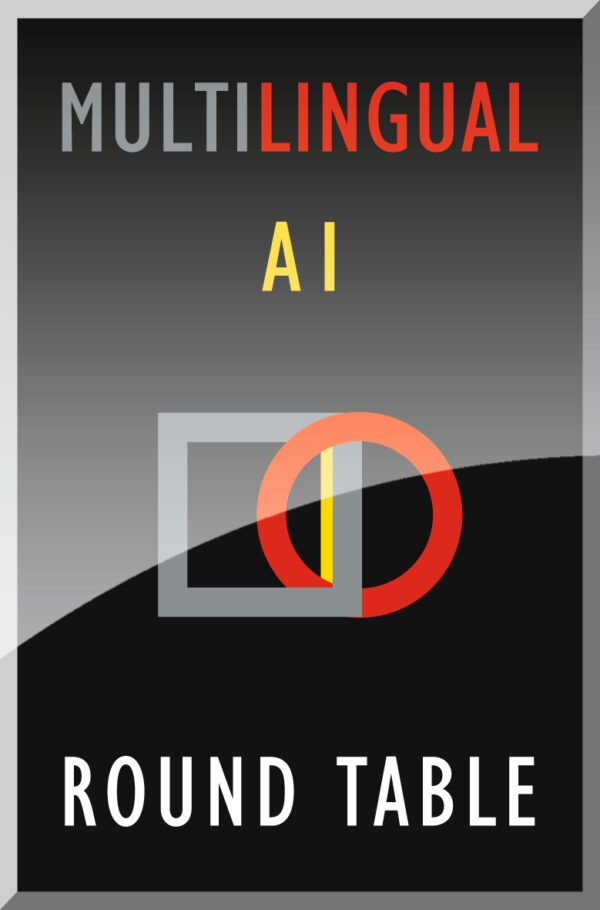Interfacing with Machine Intelligence

The 5th Multilingual AI Round Table at LocWorld Dublin 2024
Human beings are in an age when interfacing with Large Language Models (LLMs) and other AI systems at different levels is possible. Some examples include human computer interactions such as ChatGPT and system to system connections such as LLMs integrated with localization management tools. In addition, communications between humans for the purpose of improving machine learning will contribute to productivity as well as competence, in relation to data understanding, preparation, and modeling.
Interfacing helps address the challenges of both machine and human intelligence, that is, the impossibility of observing the hidden, internal processes. Intelligence is like a black box for most people. To understand and use machine intelligence, the general population must focus on the outcomes of machine intelligence. These observable AI interfaces include data (linguistic behavior), human efforts associated with AI implementation (human behavior), and Application Programming Interface (API) connectivity between AI tools and supporting technologies.
Machine Intelligence and Machine Learning
Artificial Intelligence (AI) is not simply automation, or task repetition. AI is programmed to learn (and evolve) from the inputs it receives. This results in the system making decisions on its own. While AI describes the capabilities of computer systems, machine learning (ML) focuses on the learning process that AI uses to train computer systems to complete a task, just like human learning processes.
There are two types of basic ‘algorithms’ to leverage computing power. An algorithm is a set of instructions that computer software follows to complete a task. If a person wants a machine to make a cup of tea, they can create a recipe (a set of step-by-step instructions), writing out each line of code to tell the machine what to do. However, algorithms for machine learning are different. Instead of giving the system the recipe, they give a lot of examples of cups of tea, and program it to generate the recipe by itself. The system continuously tests out different combinations (e.g. parameters of a neural network), comparing the outcome against the cup of tea users intended to have. Finally it creates a recipe that is as close as possible to the one users want. Instead of programming the computer to solve a task directly, a machine learning algorithm aims to enable a computer to learn from data. This learning ability is the essence of machine intelligence.
AI is enhancing human potential to handle complex systems and problems. Machine-generated computational modeling and pattern recognition are significantly complex, in relation to computing. In artificial neural networks, for example, there are trillions of neurons and parameters, all of which are difficult to trace with manual effort. In this sense, the inner workings of both human and machine intelligence are hidden. Thus internal processes must be observed from what can be seen and felt by humans. We observe and draw inferences from human behavior. For machines, we make use of data generated by humans to train and test the models. Both human and machine intelligence have internal aspects that are hidden and complex.
The Symbiotic Relationship between Machine Intelligence and Data
Data is essential for machine learning. The advances in many application areas of machine learning, such as Natural Language Processing (NLP), are largely due to the fact that people now have sufficient data and enough computing power to train ML models robustly.
Data allows machines to identify which answers are correct or not. When training computer systems, different types and amounts of data are given to the model to learn. The techniques or ‘styles’ of learning vary as well. For example, in reinforcement learning, the algorithm learns to do a task by interacting with an environment. While humans can learn and interact with an environment in a natural way, the way a computer system accesses data must be controlled and manipulated by humans. For example, the words a person speaks and hears every day are examples of language data. Conversely, in a machine learning process, data is entered into a computer by developers at the model development phase or by users at the deployment phase.
Thus AI-driven risks are primarily related to data as well as human judgements associated with this information. When people gather data to train a model, they are embedding their positive or negative biases in the training process. All relevant choices, such as what data to choose, how frequently to collect data, and what conditions must be met for data cleaning, are impacted by human judgements. Under these influences, models will learn certain relationships more frequently or efficiently.
Interfacing with Machine Intelligence
Data as well as its associated human behaviors and cognitive activities serve as an interface for humans to interact with machine intelligence. As a matter of fact, algorithmic activities also produce an interface for human computer interaction. Yet these activities are mostly conducted by a group of people with specialized knowledge, such as programmers. To begin, the focus is on data driven ML interfaces, which involve all users who interact with AI products.
In the context of multilingual communication, such interfaces with machine intelligence include:
- Source text generation/improvement
- LLMs as an end user tool for a range of NLP tasks (machine translation, summary, information extraction, etc.)
- LLM-driven localization management systems
- Localization management systems with plug-in LLM solutions
- Data management systems for machine training
- Quality assurance (quality estimation, automatic quality evaluation, auto MQM, automatic post-editing, etc.)
- LLMs for media localization
Concluding Remarks
An interface could both uncover and limit the potential of a system. For example, Chatbot GPT is capable of answering questions but at the same time, it can do so much more than respond to user prompts in a different interface. One interface highlights only part of the system capability. Thus, interfaces have variations based on needs or business goals. In this sense, an interface is an implementation outline. Beginning from that point, stakeholders can develop a detailed implementation plan for their part of the work. A higher degree of potential can be achieved through the design and development of other interfaces. Thus, people must continue to dynamically explore the potentials of interfacing with machine intelligence.
Appendix
Are you interested in learning more about the last Multilingual AI Roundtable that was held at LocWorld50 Silicon Valley back in October 2023? Check out the following infographic for “Feel the pulse of AI” (see Figure 1).

Figure 1: Feel the pulse of AI, Multilingual AI Roundtable at LocWorld Silicon Valley 2023 (Created by Dr. Peng Wang)
Acknowledgement
I would like to thank Megan Reid for her pertinent advice in helping me improve the writing of this article.
Machine Translation Master Class
In addition to organizing the Multilingual AI Roundtable, Dr. Wang also teaches the online Machine Translation Master Class at The Localization Institute. The next offering of this class runs from April 22 – May 13, 2024. Visit the course page for more information and to register.
Disclaimer: Copyright © 2021 The Localization Institute. All rights reserved. This document and translations of it may be copied and furnished to others, and derivative works that comment on or otherwise explain it or assist in its implementation may be prepared, copied, published, and distributed, in whole or in part, without restriction of any kind, provided that the above copyright notice and this section are included on all such copies and derivative works. However, this document itself may not be modified in any way, including by removing the copyright notice or references to The Localization Institute, without the permission of the copyright owners. This document and the information contained herein is provided on an “AS IS” basis and THE LOCALIZATION INSTITUTE DISCLAIMS ALL WARRANTIES, EXPRESS OR IMPLIED, INCLUDING BUT NOT LIMITED TO ANY WARRANTY THAT THE USE OF THE INFORMATION HEREIN WILL NOT INFRINGE ANY OWNERSHIP RIGHTS OR ANY IMPLIED WARRANTIES OF MERCHANTABILITY OR FITNESS FOR A PARTICULAR PURPOSE.





